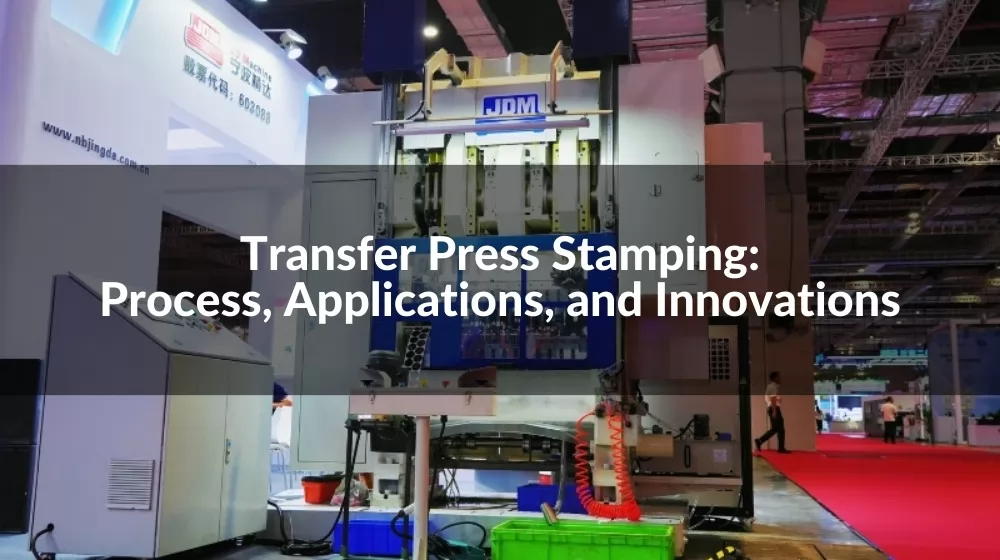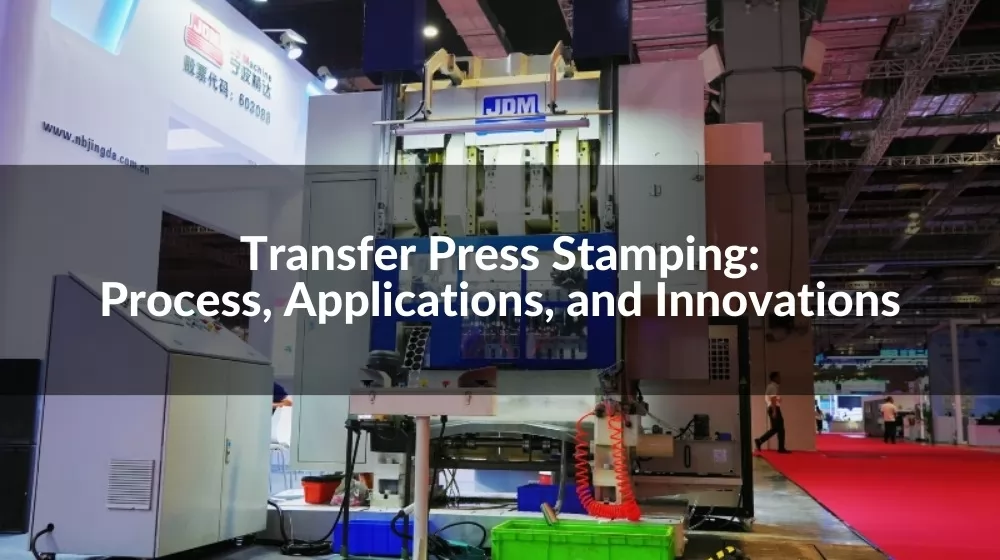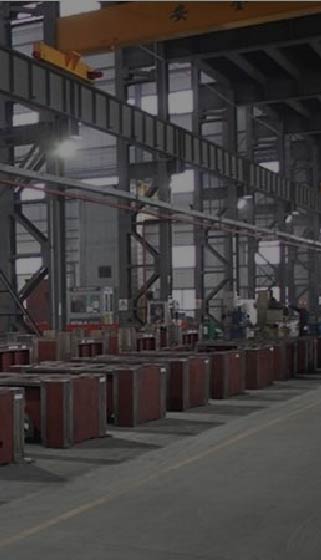








Welcome to the fascinating world of Transfer Press Stamping – a realm where precision engineering meets innovative manufacturing. This comprehensive guide delves into the intricacies of transfer press stamping, revealing its pivotal role in shaping modern industries. From automotive marvels to groundbreaking aerospace components, transfer presses are the unsung heroes behind many of today’s technological advancements. Join us as we unravel the complexities of this process, its applications, and the cutting-edge technologies driving its evolution.
Have you ever wondered how intricate metal parts in machines, vehicles, or even household appliances are shaped with such precision? The answer often lies in a sophisticated process known as Transfer Press Stamping. This technique, a cornerstone in modern manufacturing, blends art and science to transform metal sheets into complex, high-quality components.
At its core, Transfer Press Stamping involves multiple stages. Starting with a flat metal sheet, the process sequentially stamps the metal through various stages of pressing. Each press, or station, in the transfer press performs a specific action - bending, drawing, punching, or trimming - gradually shaping the metal into its final form. This multi-stage approach allows for the creation of intricate designs and precise dimensions, essential in today’s high-tech industries.
But why choose Transfer Press Stamping over other methods? Efficiency and precision are the key answers. This method is remarkably efficient for mass production, producing large quantities of parts with consistent quality. Moreover, it’s adaptable to various metals and alloys, making it a versatile choice for diverse applications.
The impact of Transfer Press Stamping is evident across industries. From automotive to consumer electronics, this process plays a pivotal role in manufacturing the complex components that power our daily lives. By understanding its fundamentals, businesses can better appreciate the value it adds to their products and the possibilities it opens up for innovation.
The heart of Transfer Press Stamping lies in its press – a powerful machine capable of exerting tremendous force. The press is designed to handle heavy-duty operations, applying consistent pressure to shape and mold metals. Its robust construction ensures precision and durability, vital for producing high-quality parts. In the world of manufacturing, the press isn't just a tool; it's the cornerstone that determines the efficiency and capability of production.
Next up is the transfer mechanism – the dynamic part of the system that moves the workpiece through different stations. This mechanism is what makes Transfer Press Stamping unique. It carefully transfers the metal sheet from one stage to another, ensuring that each part is precisely aligned for the next step. The transfer mechanism is a marvel of engineering, synchronizing the movement of parts with the stamping actions, thereby enhancing productivity and minimizing errors.
Lastly, the unsung heroes of Transfer Press Stamping are the dies and tooling. These custom-designed components are responsible for the actual shaping of the metal. From intricate cuts to precise bends, the dies and tooling dictate the quality and complexity of the final product. Their design and maintenance are crucial, as they directly impact the efficiency and output quality of the stamping process. In essence, they are the molds that bring the creative designs of engineers to tangible reality.
Mechanical transfer presses are the traditional powerhouses in the realm of Transfer Press Stamping. Known for their speed and reliability, these presses utilize mechanical linkages to convert rotational motion into linear stamping action. Ideal for high-volume production, they offer remarkable precision and speed, making them a popular choice in industries where time and accuracy are paramount. The mechanical nature of these presses also allows for easier maintenance and longevity, an essential factor for businesses looking to maximize their investment.
In contrast, hydraulic transfer presses leverage the power of hydraulic fluid to execute the stamping process. These presses are renowned for their ability to apply consistent, controlled force, making them ideal for working with delicate or intricate designs. Their adjustable pressure settings provide a level of versatility unmatched by mechanical presses, allowing for a broader range of applications. Moreover, hydraulic presses tend to operate more quietly, reducing noise levels in the working environment.
The latest innovation in this field is the servo transfer press. These presses integrate servo motors, offering unparalleled control over the stamping process. The key advantage of servo transfer presses lies in their flexibility and precision. With programmable settings, they can be adapted for complex and varied production runs with minimal downtime for adjustments. This adaptability, combined with their energy efficiency, makes servo transfer presses a forward-thinking choice for industries focusing on customization and sustainability.
_1703214000_WNo_800d600.webp)
The journey of Transfer Press Stamping begins with feeding the material. This initial step involves loading a flat metal sheet or coil into the press. Precision is key here, as the correct alignment of the material ensures accuracy in subsequent processes. Automated feeding systems are often used to maintain consistency and speed, setting the stage for efficient and error-free production.
Next comes the cutting and shaping phase. Here, the press exerts its might, using dies to cut the metal into specific shapes and form intricate designs. This stage is where the magic happens – turning a plain sheet of metal into a part with potential. Each cut and bend must be precise, as this forms the foundation of the final product's functionality and aesthetics.
After the initial shaping, the workpiece undergoes transferring. In this crucial phase, the partially formed part is moved from one station to the next within the press. The transfer mechanism ensures that this movement is smooth and precise, aligning the workpiece accurately for each subsequent operation. This step is essential for multi-stage stamping processes, where each station adds further detail to the part.
The final step in the stamping cycle is the ejection and collection of the finished product. Once the part has passed through all the stamping stages, it is ejected from the press and collected. This phase might include quality checks to ensure each piece meets the required standards. The efficiency and precision of this final step are crucial to maintaining high productivity levels and minimizing waste.
In the world of Transfer Press Stamping, the choice of metal is crucial. Commonly, materials like steel, aluminum, copper, brass, and various alloys are used. Each metal brings its unique properties to the table. Steel, known for its strength and durability, is a go-to for automotive and construction industries. Aluminum, lightweight yet strong, is favored in aerospace and consumer electronics. Copper and brass, with their excellent electrical conductivity, are indispensable in electrical components.
The thickness and properties of these materials are equally important. Material thickness impacts the stamping process's capabilities and the end product's performance. Thicker metals offer robustness but require more force to shape. Conversely, thinner materials are easier to manipulate but might lack in structural integrity. The material's properties, like ductility, malleability, and tensile strength, dictate the methods and tools needed for effective stamping. Understanding these aspects is vital for manufacturers to achieve the desired quality and functionality in their products.
The automotive industry heavily relies on Transfer Press Stamping for producing various components. From engine parts to body panels, this method offers the precision and efficiency required for high-volume production. The strength and durability of stamped parts are essential for safety and performance in vehicles, making transfer press stamping a cornerstone in automotive manufacturing.
In aerospace, the stakes are high, and the demand for precision is even higher. Transfer Press Stamping is utilized to create components that are not only precise but also lightweight and strong. This process is critical for producing parts that meet the rigorous standards of the aerospace industry, where every gram and every millimeter counts.
The consumer electronics sector benefits immensely from the miniaturization capabilities of Transfer Press Stamping. This technique allows for the production of small, intricate parts essential in devices like smartphones, laptops, and tablets. The ability to work with a variety of metals makes it an ideal choice for the diverse components required in consumer electronics.
Medical device manufacturing is another arena where Transfer Press Stamping plays a vital role. The need for precision, reliability, and sterility in medical devices makes this method highly suitable. Whether it's surgical tools or implants, the ability to produce complex, high-precision parts is essential in the medical field, where quality and accuracy can directly impact human health.
Precision is paramount in Transfer Press Stamping. Quality control measures are essential to ensure that each part meets stringent specifications. This involves regular inspections, meticulous maintenance of equipment, and adherence to standardized procedures. Advanced measuring tools and technologies are often employed to monitor and maintain the accuracy of stamped parts, safeguarding the integrity of the final products.
Safety in transfer press operations is a critical aspect. Manufacturers implement rigorous safety measures to protect operators from the inherent risks of working with heavy machinery. These measures include emergency stop mechanisms, safety guards around moving parts, and regular safety audits to ensure all equipment is functioning correctly and safely.
Operator training is another crucial element in maintaining safety and quality. Well-trained operators are not only efficient but also key to minimizing accidents and errors. Comprehensive training programs cover machine operation, safety protocols, and troubleshooting, ensuring that operators are well-equipped to handle the complexities of transfer press stamping.
Lastly, the use of safety equipment and adherence to strict safety protocols play a vital role in safeguarding the workforce. Personal protective equipment (PPE), like gloves, safety glasses, and ear protection, is mandatory. Additionally, protocols for emergency situations, regular drills, and safety signage help create a secure and aware working environment.

Selecting the right Transfer Press for your manufacturing needs is a decision that combines technical specifications with practical considerations. Whether you're in automotive, aerospace, or consumer electronics, choosing a press that aligns with your production goals and material requirements is crucial. Here's a guide to help you navigate this decision-making process.
First, assess your production needs. Consider the volume, speed, and complexity of the parts you intend to produce. High-volume production lines might benefit from a mechanical transfer press for its speed, while intricate designs might be better served by a servo transfer press for its precision.
The type of material you plan to use plays a significant role. Different presses handle various materials and thicknesses differently. For instance, hydraulic presses are excellent for delicate materials, whereas mechanical presses can handle tougher metals more efficiently.
The physical space and infrastructure of your facility also matter. Transfer presses come in different sizes and power requirements. Ensure your facility can accommodate the press you choose, both in terms of space and electrical or hydraulic infrastructure.
Modern presses offer various degrees of automation and control. Servo-driven presses, for instance, provide high precision and programmability, which might be essential for your specific production needs.
Safety features and ease of maintenance are crucial. Look for presses with built-in safety mechanisms and that are easy to maintain and repair. This not only ensures the safety of your operators but also reduces downtime.
Finally, don't hesitate to consult with experts. Manufacturers and specialists can provide valuable insights into the latest trends and technologies, helping you make an informed choice that aligns with your production goals and budget.
In conclusion, the journey through the world of Transfer Press Stamping highlights its significance in various high-precision industries. As a leading figure in this domain, JDM, China's premier transfer press manufacturer, continues to set the standard in quality and innovation. Our state-of-the-art presses, designed with precision and reliability in mind, are empowering businesses across the globe. To explore how JDM can revolutionize your manufacturing processes, visit us at www.jdmpresses.com. Embrace the future of manufacturing with JDM, where excellence in engineering meets the pinnacle of performance.






